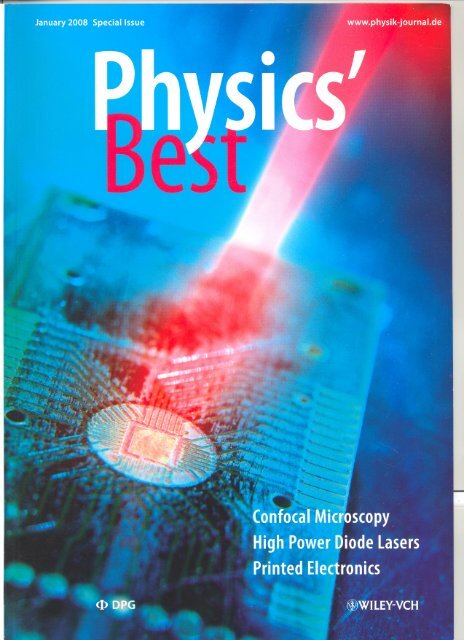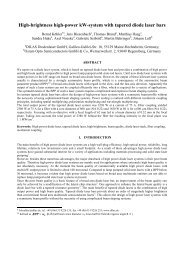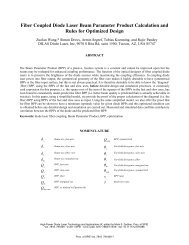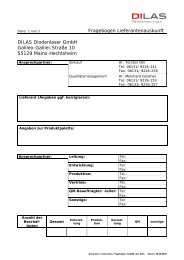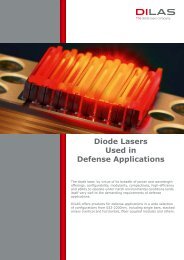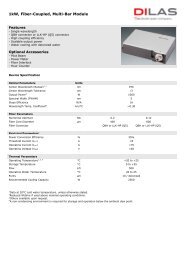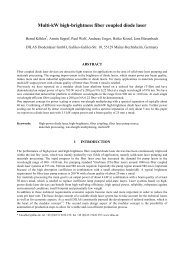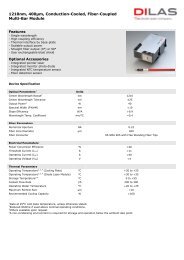3mb pdf - DILAS
3mb pdf - DILAS
3mb pdf - DILAS
You also want an ePaper? Increase the reach of your titles
YUMPU automatically turns print PDFs into web optimized ePapers that Google loves.
, LASERHigh Power Diode Lasersfor Industrial ApplicationsWolfgang HornWolfgang Horn,DILA5 DiodenlaserGmbH, Galileo-Galilei-5traBe10, 55129Mainz, GermanyNewnesswavelengths, and increasing highreliabilitybrightare breaking new ground for diodelasers. The higher brightness allowsdirect fiber coupling of several100 W in 200 fim and 400 fim fibersand therefore i.e. the pumping offiber lasers. Such high power fibercoupled laser diodes combined withfast beam deflection units (galvoscanners) have been implementedin industrial processes and usedfor quasi-simultaneous welding ofpolymers, heat treatment in the submillimeter range or selective solderingin solar cell production. Besidespumping of solid state lasers,high power diode lasers becomemore and more a competitive toolfor many applications in materialprocessing.ReliabilityHigh power diode lasers mainlyconsist of a diode laser bar, a heatsink on which the bar is mountedand some micro optics. Most importantfor a proper function ofthe laser diode is an effective heatremoval by the heat sink. In mostlaser systems two different types ofheat sinks are used.Micro-channelheat sinks withDI-water coolingDI (de-ionized) water cooledmicro-channel heat sinks have themost effective heat removal and cantherefore operate on a high powerlevel. Manufacturing very compactmulti kilowatt laser modules bystacking the laser diodes is a bigadvantage for this technology.On the other hand the coolingcircuit has to fulfill high demandsfor water quality. Purity, conductivity,flow rate and temperatureneed to be set within a certainrange to guarantee a maximumFig.1 Customized laser module for simultaneous spot welding.lifetime. For industrial productionregular maintenance and stockingof consumables like particle filtersand DI-cartridges has to be takeninto account. But even with perfectwater conditions the flow insidethe micro channels causes wearand therefore the lifetime of a laserdiode is in most cases limited by thelifetime of heat sink.Massive copper heat sinks forconduction coolingConduction cooled diode modulescombined with thermal electricalchillers (TEe) don't need any waterat all. For higher laser power theTEC gets less efficient and has tobe replaced by a water cooled plate.Compared to micro channel heatsinks the heat removal and thereforethe maximum laser power islimited. Direct stacking of conductioncooled diodes is not possible.The demands for the cooling circuitand the integration of a conductioncooled laser diode into a turnkeysystem are low. The temperatureof the diode is measured inside theheat sink. Additional flow or temperaturesensors are not needed.The lifetime is mainly limited by thesemiconductor material because theheat sink is free of wear. Conductioncooled diodes are mostly used forfiber coupling where the size of thelaser module is not as important asfor direct beam applications.But for some customizedsolutionsit can be advantageous touse the direct beam. Figure 1 showsa laser module which is used forsimultaneous welding of 10weldingspots. Four of these modules areintegrated in a production line forsyringes. The module consists of10 conduction cooled laser diodesmounted on a common watercooled plate. [1]Besides all other aspects reliabilityand availability are most importantissues for production. Duringthe last years diode lasers improvedto fulfill the demands of industrialstandards. Micro-channel and conductioncooled diodes both showlifetimes of more than 14,000 hourscw operation (Fig. 2) and 16 millioncycles in pulsed mode (Fig. 3) withminimal degradation. Byextrapolatingthese data the estimated chiplifetime is more than 40,000 hours.Depending on the operating conditions,such diode lasers have alreadyproven to run for several years inproduction.Higher OutputNew WavelengthNew semiconductorPower andmaterial deliversmore laser power per bar.InGaAIAs based chip material withemission at a wavelength of 808 nmhas shown up to 120W laser power.16 Physics' Best January 2008 © 2008 Wiley-VCH Verlag GmbH &Co. KGaA,Weinheim
Compared with diodes used todaythe efficiency increased from about55 % (60 W output power) to morethan 62 % (100 W output power) [2].With InGaAs based semiconductormaterial at 940 nm opticalpower of up to 170 W can be achieved.Such highly efficient chips allowthe increase of output power ofdiode stacks and modules withoutany other design changes. The ongoinglifetime tests show promisingresults. With the good beam qualityavailable, the laser radiation can becoupled into 200 11mand 400 11mfibers. Fiber coupled diode lasersare not only used for materialsprocessing but also for pumping ofsolid state lasers and especially forfiber lasers.With higher laser power also fornon-standard wavelengths a largenumber of different applicationscan be addressed (Table 1). Just tomention InGaAs on InP substratesfor wavelengths> 1300 nm and(AlGaIn)(AsSb) on GaSb substratesfor wavelengths> 1800 nm. In thesewavelength ranges, high powermeans 10... 20 W per laser diode bar.Examples are direct medical oraesthetic applications like photodynamictherapy and hair removal.Printing industry and defence technologytake also advantage of dedicatedwavelengths. Table 1 gives anoverview about typical applicationfor different wavelengths.New ApplicationsArisingSeveral years ago most integratorsused direct diode lasers in theirproductionlines. With increasingIbeam quality, I the coupling intoI60IIiiIIIIsmaller fiber diameters I with IIhigherII Ilaser power opened new! optionsIfor material processing. Due to theadvantages for industrial productionmost of the systems today areequipped with fiber coupled diodelasers. Even if the laser moduleneeds to be exchanged, an easy onsitereplacement can be done withina short time. The possibility of aplug and play diode exchange is increasingthe availability of the lasersystem for production. Because ofthe independence oflaser sourceand processing head new teachingof the process is not necessary: theprocessing head stays inside thelaser cell. Using conduction cooleddiode laser modules the system canrun nearly maintenance free. Nocomplex and costly cooling unit isneeded. Up to 100 W laser outputcan be generated using an air cooledPeltier-chiller without any water.A turn-key diode laser systemfeatures the laser module and allits supply and control units in a 19"rack mountable chassis. The setup gets completed by a fiber, beamshaping and/or focusing opticswith complementary features forprocessing control and surveillance.For example the integratedpyrometer has been established as ahelpful tool for many applications.Turn key systems become morecompact and easy to integrate.Figure 5 shows the new <strong>DILAS</strong> turnkey diode laser system family: TheCOMPACT series which fulfilsall demands of a state-of-the-artproduction tool. It will be introducedon the LASER 2007 show inMunich and completes the <strong>DILAS</strong>I ioo 2000 4000 6000 8000 10000 12000 14000 16000Time [hours]Fig.2 Lifetime tests with Dj-water (pink) and conductioncooled (blue) single diode laser bars in cw operation.product range, starting from singlebars up to full featured, stand alonelaser systems.The main applications in materialsprocessing in the power rangeup to several hundred Watts aresoldering and polymer welding.Especially in polymer welding thediode laser has technical advantagescompared with other laser typesand technologies like ultrasonicwelding. For typical widths of thewelding seams of more than 1mmthe homogeneous energy distributionin the focal plane with a big laserspot, compared with other lasers,leads to excellent results. The usageof galvo scanners makes the highlyflexible diode lasers even moreflexible and allows quasi simultaneouswelding of closed contoursoften needed for sealing all typesof housings used in medical devicemanufacturing and automotiveproduction. As part of the ROFINgroup, <strong>DILAS</strong> can offer galvo solutionswith an advanced softwarepackage used for marking systemsand world wide support.High power diode laser are alsoused as a flexible and precise toolII700 20~OI1012 16 18 2468 142040max, efficiency: 63.52 % Current (A)14' 12"1 1060d: 2060~ 807060 ~50 [3140 ~.30~
LASER~•••• <strong>DILAS</strong>...Fig.5 Turn key diode laser system forproduction: <strong>DILAS</strong> COMPACT.•in solar cell manufacturing. Mostsilicon solar cells are interconnectedwith pre tinned copper ribbons tostrings by conventional soldering.The soldered strings are then laminatedinto modules. The handling ofthese long and fragile strings is difficultand needs complex equipment.Using In-Laminate Laser Soldering(ILLS) technique developed by theInstitute for Solar Energy ResearchHameln (IFSH) the very thin solarcells are interconnected to a moduleby placing cell and ribbon on theirfinal position onto the laminate. Thelaser beam is soldering cell with ribbonand the handling of the stringscan be avoided completely.The achieved electrical contactresistance is below 0.1 m [2 cm2 andthe peel forces exceed lON/em. Asknown from electronic productionthe laser is well suited for the useof lead free solder. To increase theprocess stability the soldering isdone with a closed loop temperaturecontrol. The pyrometer is integratedin the processing head andaligned in the optical path of thelaser beam. Compared to standardsoldering methods laser solderingis contactless and produces nomechanical stress. The localizedheating minimizes the thermalstress for the solar cells which havea thickness below 200 fim. The ILLStechnology allows producing thinnerand therefore cheaper siliconwafers. [3]Summaryand OutlookDiode laser bars and modules havebecome a reliable and long livingproduct. The conduction cooleddiode lasers can be operated witha simple cooling device. New semiconductorsallow high efficientfiber coupling in small fibers. Allthese attributes put the availabilityof diode laser systems in an industrialproduction chain on a veryhigh level.The joint research initiativeBRIOLAS of the Federal Ministryof Education and Research (BMBF)in line with the actual research program"Optical Technologies for the21st Century" is following the increasingdemands from the market toimprove brilliance and reliability ofhigh power diode lasers. With newtechnologies the field of technicallyfeasible and economically reasonableapplications will be expanded.References[1] W Horn, Flexible kundenspezifischeLosungen zum KunststoffschweiGen,6. Workshop Anwendung vonHochleistungsdiodenlasern, Dresden,Germany (2006)[2] New generation oflaser bars in thestarting blocks: World record efficiencyfor 808 nm achieved in the laboratory,www.briolas.de. April 2006[3] M. Gast, M. Kontges, R. Brendel, InLaminate Laser Soldering - A GentleMethod to assemble and interconnectsilicon solar cells to modules,21st EuropeanPhotovoltaic Solar Energy Conference,Dresden, Germany (2006)Turbulence Vb: Vb'· Medicai Acne, Missile TM'·: Diode Applicationage-related Cr'·: YbH Pre-Press, NdH Nd'· Nd:YAG hair RangefinderRb'· MedicalGlas, removal, :YAG, f: LiSAF :YLF SFAB Glass, Turbulence XXX Xe'39f PumpedDefensePhotodynamic Fiber Computer => (various Disk - Detection, -Fiber macular fs-Laser direct pumping 2etc. Laser, Ilm Gas Laser Detection host Laser degeneration Medical to Plastic Therapy plate crystals) (Caesium (Rubidium Er (CTP), weldingDefense, 3+ pumping Vapor) InstrumentationPrintingDPSSL, IndustryMedical, Direct Medicalvarious Material press (DOP) othersProcessing processingTab. 1:Diode laser applicationsWavelength18 Physics' Best January 2008 © 2008 Wiley-VCH Verlag GmbH & Co. KGaA,Weinheim


